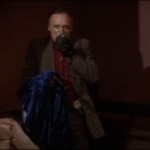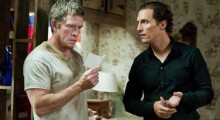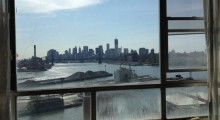Columns
-
2 Days in New York — A Hammer to Nail Review
(2 Days in New York world premiered at the 2012 Sundance Film Festival and was picked up for distribution by Magnolia Pictures. It is available through various VOD outlets—Amazon, iTunes, etc.—on July 6, 2012, and opens theatrically on August 10, 2012. Visit the film’s official website to learn more.) I’ve been known to knock the French, toodling around on bicycles with their phallic baguettes, vin rouge, and perennial boredom with all things Americain. But is there any way to withstand the Julie Delpy charm offensive? She had me at bonjour in this witty comedy, a sequel to her earlier film 2 Days in Paris. Delpy (who wrote and directed the film) […]
-
The Blue Velvet Project, #148

Second #6909, 115:09 (Note: there are six posts remaining in the project, which will conclude with #154 on August 24.) 1. The seconds preceding this frame show Sandy and Jeffrey in the hallway outside Dorothy’s apartment, embracing, kissing, the shot slowly blowing out to blinding white before fading back into this shot, a close-up of Jeffrey’s ear as he lays dozing (dreaming?) on a lounge chair in his parents’ back yard. 2. The black frame, from earlier, as balance. 3. Is Jeffrey emerging from the dream that has been the film? When Jeffrey awakes in his lawn chair in his […]
-
The Blue Velvet Project, #147

Second #6909, 115:09 Detective Williams arrives, too late. Everyone dead is dead. Jeffrey is alive, but not because of the Law. Sandy, behind her father, behind the gun, swoons, electrified and ready to be taken by Jeffrey. This post is as good a post as any to suggest that, just beneath its surface, Blue Velvet is a “trash” film. It’s so overloaded with references to Hollywood’s traditions that always threatens to implode in on itself, perhaps nowhere else more poignantly than in this frame, which evokes everything from noir to the “woman’s picture” to the classic crime film. In Avant-Garde […]
-
The Blue Velvet Project, #146

Second #6862, 114:22 In an unnervingly comic touch Frank approaches the closet where Jeffrey hides loaded up with his props, which include Dorothy’s blue velvet gown and his gas mask. He is the exterminator now, inhaling his chemicals, approaching Jeffrey and, ominously, the camera. For Frank has seen us, now. The invisible camera has been called out, hailed, interpolated. Frank stares back at us, returning our gaze, just as the bandit, gun in hand, did in Edwin S. Porter’s 1903 film The Great Train Robbery: Out of the shadows he comes, Dorothy’s tortured, neck and wrist bound husband at his […]
-
The Blue Velvet Project: Confession
Confession With just 9 posts to go, I herein and forthwith offer my final confession. As author of The Blue Velvet Project—which owes a moral debt to the Dogme 95 movement, whose practice of constraint was an inspiration—I feel obligated to make this public statement of confession regarding the rigors of the project. This is done in the spirit of Thomas Vinterberg’s confession regarding his film The Celebration. In post #143, I confess to knowing well in advance that I would not write much at all about the frame in question. I had been saving the William James quote for […]
-
The Blue Velvet Project, #145

Second #6862, 114:22 Jeffrey, taking the gun from the Yellow Man’s jacket pocket, as Frank is in the bedroom, shooting. In addition to Jeffrey and the Yellow Man, there is the camera, or at least its presence, invisible in accordance with classical cinema’s codes, which, even after the deconstructive storms of postmodernism, are themselves invisible, having been absorbed into the very technologies that make film possible. In Blue Velvet, for the most part, the camera does not call attention to itself; most of its movement is motivated, aligned with, and justified by corresponding movements in the film’s narrative. And yet […]
-
The Blue Velvet Project, #144

Second #6768, 112:48 Fragments: 1. Frank’s back to the camera. 2. Dorothy’s apartment stretched out in horizontal like a widescreen nightmare. 3. The vintage fridge, solid. 4. The black circle mirror above the bathroom pedestal sink. (If Roberto Bolaño had done the set design for Blue Velvet, the mirror would have been inscrutably evil.) 5. The silencer, attached. 6. The sconce on the wall above the couch, looking at first glance, in its isolated away, like the screaming mouth on Jeffrey’s wall. 7. The sadness of Dorothy’s husband’s dead paunch. 8. Frank’s death in under two minutes, uncertain at this […]
-
Killer Joe — A Hammer to Nail Review

(Killer Joe world premiered at the 2011 Venice Film Festival. It is being distributed by LD Entertainment and opens theatrically on July 27, 2012. Be forewarned, gentle viewer: this one has an NC-17 rating! Visit the film’s official website to learn more.) As I get older with each passing year, I’ve begun to process the world—and, by extension, cinema—in a different light. While I’m not turning into an outright prude, I am becoming much less tolerant of art and entertainment that takes a condescending and contemptible attitude towards humanity. On an ethical, theoretical level, there’s no denying that the way […]
-
The Blue Velvet Project, #143

Second #6721, 112:01 In an essay from 1929, “The Filmic Fourth Dimension,” Sergei Eisenstein wrote about the impossibility of “the single-meaningness” of the film frame, which “can never be an inflexible letter of the alphabet, but must always remain a multiple-meaning ideogram.” And part of the frame’s meaning lies outside of the frame itself, in the implied off-screen space that surrounds it, accumulated in fragments from places the film has already taken us. In the frame above, Jeffrey is in Dorothy’s bedroom, laying his trap for Frank, whom he knows is listening as he reveals his false location to Detective […]
-
This is Where You Work: Eve Sussman

What sparks creativity? It’s safe to assume that an artist’s work environs affect the process of art-making, so perhaps it’s possible by examining those environs to find some of the seedlings of ideas, of productivity, that space engenders to get the mind to engage with work. That was the idea behind the “This Is Where You Work” series, and when I turned my focus to my first subject, filmmaker Braden King, I was a bit shocked by how relevant the idea was – the items and artifacts filling King’s workspace created a sort of map of his personal life and […]








